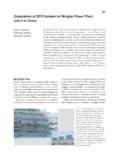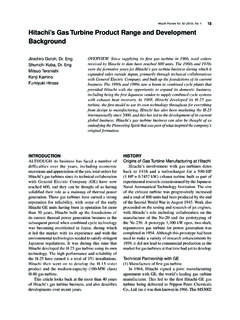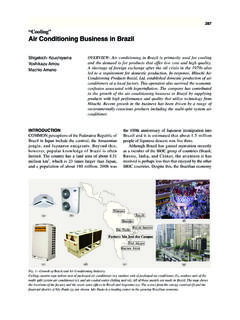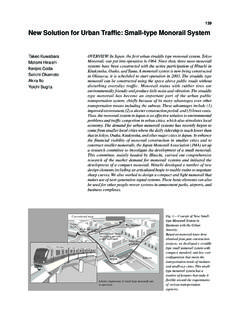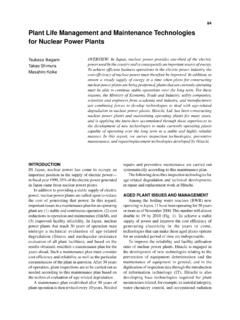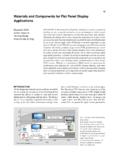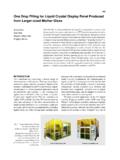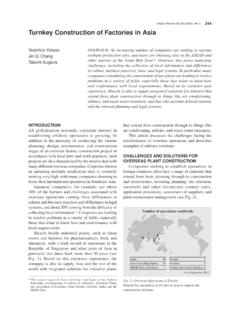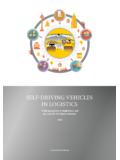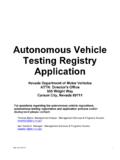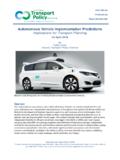Transcription of Chassis Control Systems for Safety, Environmental ...
1 Hitachi Review Vol. 63 (2014), No. 2 122. Chassis Control Systems for safety , Environmental performance , and driving Comfort Tadahiko Nogami OVERVIEW: Chassis subsystems, such as suspensions, steering, and brakes, Motohiro Higuma play an important role in determining driving , cornering, and stopping Yasuhiko Amari performance of a vehicle. Hitachi supplies a wide range of such products and has drawn on technologies, which have built up with conventional Fumiyuki Yamaoka products to incorporate electronics and electric drive into these Systems . By Mitsuo Sasaki drawing on capabilities from throughout Hitachi, including making further enhancements to cooperative Control techniques for electric powertrains of HEVs and EVs and for engine-driven powertrains (a field in which progress is being made on improving fuel economy), integrating information and recognition Systems such as car navigation and cameras, and developing Systems for integrated Control of Chassis subsystems and for autonomous driving , Hitachi is seeking to be a supplier that can provide the entire world with vehicles that are safer, greener, and more comfortable.
2 INTRODUCTION from cameras and radar, and information acquired via ELIMINATING traffic accidents is an ever-present car-to-car communications and car-to-infrastructure objective for society, and factors such as aging drivers communications, with growing activity in the are behind stronger demand for accident prevention development of technology that has potential for use Systems . Along with electronic stability Control in autonomous driving Systems . Through integrated (ESC) for preventing skidding, there are also moves Control involving the cooperative interoperation of toward mandating Systems that brake automatically in these technologies with Chassis Control Systems , emergent situations. Hitachi is picking up the pace of development for Meanwhile, hybrid electric vehicles (HEVs) Systems that further enhance safety , Environmental and electric vehicles (EVs) are entering wider use performance , and driving comfort of vehicles (see in response to growing Environmental awareness Fig.)
3 1 and Fig. 2). prompted by global warming. These electrically powered vehicles require Systems that cooperatively Control friction and regenerative braking (braking Stereo camera using electric motor), and also electric drives for subsystems such as power steering and braking to e-ACT Hydraulic cylinder for roll Control avoid relying on drive force or vacuum provided by Brake actuator engine. Progress is also being made on innovative ADAS. techniques for improving fuel economy of engine- ESC Control unit powered vehicles, with growing demand for Systems that can turn off engine not just during idling, but also Air leveling system prior to stopping or when coasting. Suspension shock absorber Semi-active and active suspensions not only Brake Power enhance ride comfort and improve handling, they also calipers steering Propeller shaft help make evasive action more effective and reassure ESC: electronic stability Control e-ACT: electrically-assisted actuation passengers by maintaining stability when trying to ADAS: advanced driver assistance system avoid an accident.
4 Fig. 1 Chassis Control system Products. Development continues on further improvements to Hitachi supplies a variety of products for Chassis Systems , which safety , achieved by utilizing information such as map play an important role in determining the driving , cornering, data from car navigation Systems , recognition data and stopping performance of a vehicle. - 67 - 123 Chassis Control Systems for safety , Environmental performance , and driving Comfort Autonomous driving Collision ze Compact, ler si avoidance assistance low-cost ESC Smal Integration with car navigation Electronic Compact Compact ESC ESC for use Emergency braking ESC. for use with Additional stability electrically-assisted with ITS functions LKS actuation Control ACC ESC with Steer-by-wire boost function Steering out EPS Operation withce vacuum sour Hydraulic power steering Active suspension Suspension Semi-active suspension Suspension shock absorber Electrically- assisted Electrically- ter ESC actuation and ligh Electrical assisted actuation Smaller ABS Cooperative actuator for mass-market regenerative brake Brakes e-ACT Electric brake Brake actuator (vacuum booster) e-PKB.
5 On e-PKB rdizati Brake calipers e-PKB Standa 2010 2015 2020. ACC: adaptive cruise Control LKS: lane keep support EPS: electric power steering ABS: antilock brake system e-PKB: electric parking brake ITS: intelligent transport Systems Fig. 2 Advances in Chassis Control Systems . Fig. 3 Roadmap for Controlled Brakes. By drawing on technologies it has developed with conventional With a product range that includes skidding prevention Systems , products to incorporate electronics and electric drive and electric actuator, and e-PKBs, Hitachi supplies brake Systems enhance cooperative Control techniques, Hitachi is creating that cover everything from normal driving conditions to extreme vehicles that are safer, have better Environmental performance , cases. and are more comfortable. ESC. This article describes the current state of ESC Systems use sensors to monitor for behavior development of Chassis Control Systems and the of vehicle instability (tire lock, wheel spin, vehicle outlook for the future.)
6 Spin, and drift-out), and Control the braking force at each wheel to stabilize the vehicle. Hitachi has been BRAKE system commercializing the pressure sensor-less compact Developments in Brake Technology ESC Systems since 2003. Next generation compact Brake Systems can be broadly divided into the ESC system was released in 2007 with additional service brake that decelerates a moving vehicle functions that included active rollover protection when the driver applies the brake pedal and the Control and hill start assist Control . The growing parking brake that prevents a stationary vehicle demand for ESC system is to reduce the size and from moving. In addition to braking and parking, weight and extend functionality, Hitachi is currently brake Systems are also being required to provide developing a low-cost ESC system that is 20% smaller greater safety , with antilock brake Systems (ABSs) and lighter than the current model.
7 That target is that prevent wheel lock and ESC that prevent vehicle emerging markets and small vehicles. spin and drift-out that becoming standard features. Meanwhile, the function controls the brake force The safety , comfort, and Environmental performance to stabilize the vehicle behavior and the function of of vehicles have also been improved through optimal autonomous brake cooperates with camera, radar Control of the braking force, with greater use being and/or other sensors operate not only the emergency made of electric drive in parking brake mechanisms condition but normal driving condition. Because of and devices for boosting the braking force applied the need, ESC should be quieter, more responsive, by the driver. Controlled brakes have become critical and more durable, Hitachi is developing a system that parts when considering the performance of modern utilizes its own gear pump technology.
8 Vehicles. Against the background of these trends, As small vehicles, HEVs, EVs, and fuel-efficient Hitachi is developing ESC, electrically-assisted green vehicles are being more widely adopted, and so actuation, and electric parking brakes (see Fig. 3). there is growing demand for brake boost mechanisms - 68 - Hitachi Review Vol. 63 (2014), No. 2 124. that do not rely on vacuum from the engine. Hitachi is of installation to allow this technology to be utilized currently developing a compact ESC system for small by a larger number of vehicle models in the future. vehicles that includes the boost function. Because the overall brake system has been made smaller and e-PKB. lighter through the integration of functions, making it There is an ongoing trend toward the use of electric easier to fit inside a vehicle, Hitachi anticipates that parking brakes (e-PKBs) with the aim of providing the new system will be widely adopted.
9 Simpler operation and greater flexibility in interior layout. To make automatic parking brakes possible, e-ACT Hitachi has minimized brake noise, increased the As an alternative brake actuation, Hitachi has been speed with which the parking brake can be released, the first in the world to develop and commercialize and adopted its own actuators, which combine its own electric brake actuator that uses a servo transmission efficiency with an ability to maintain mechanism that does not rely on vacuum from the clamping force. Through these initiatives, Hitachi is engine. Instead an electric motor assists the pedal force considering safety and the environment by reducing provided when the driver operates the brake pedal. the weight of the overall brake system , making the This electrically assisted actuation (e-ACT) calipers and motor smaller and lighter, and also includes a function for working in cooperation with ensuring that the system works with idling stop the regenerative brake on an HEV or EV (see Fig.)
10 4). Systems and collision prevention and minimization It helps improve fuel economy by utilizing the superior Systems . Control performance provided by an electric motor to obtain the optimal level of braking force from SUSPENSION Systems . the friction brake, thereby significantly increasing Developments in Suspension Technology energy regeneration by the regenerative brake. It Through its influence on ride comfort and also enhances vehicle safety and driving comfort by handling, the suspension is an important system utilizing the precise Control performance of e-ACT for ensuring driving comfort by providing a sense to implement automatic braking and other intelligent of stability and reassurance and by being less tiring transport system (ITS) functions in conjunction with for the driver. In particular, controlled suspensions sensors such as cameras or radar.
